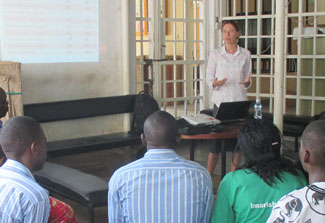Profile: Fogarty Fellow Dr Jennifer Syvertsen documents drugs and HIV risk in Kenya
July / August 2015 | Volume 14, Issue 4

Photo courtesy of Dr. Jennifer Syvertsen
As a Fogarty Fellow, Dr. Jennifer Syvertsen measured patterns of
drug injection and HIV risk in the Nyanza Province of Kenya.
As a medical anthropologist, Dr. Jennifer Syvertsen was keen to immerse herself in local Kenyan culture. From the outset of her Fogarty fellowship in Kisumu, her intent was to learn and help, not judge and disrupt. Acceptance was key to gaining cooperation from the stigmatized communities of people who inject drugs and are at heightened risk for acquiring and transmitting HIV.
Syvertsen studied this population as part of her fellowship project for Fogarty's Global Health Program for Fellows and Scholars, which provides yearlong mentored clinical research experiences overseas for postdoctoral fellows and pre-doctoral scholars. Funding also came from NIH's National Institute on Drug Abuse (NIDA). Kisumu, in the western Nyanza region, has the country's highest HIV prevalence at more than 15 percent. Until her project, no scientist had measured patterns of local drug injection and HIV risk.
Previously, Syvertsen had studied drug use and infectious disease along the Mexico-U.S. border, focusing on how social and emotional factors shape HIV risk among female sex workers and their intimate, noncommercial partners. In Kenya, she was conducting research in a different culture with the goal of clarifying who was injecting and how this practice might contribute to HIV spread. She and her Kenyan research assistants surveyed 151 injection drug users and interviewed 29 in-depth. The users overwhelmingly were young men, and half had spent time outside of Nyanza. Top factors linked to HIV infection were a history of sexually transmitted disease symptoms and needle sharing.
Syvertsen's study in this Kenyan community highlighted the need to clarify the various factors that influence people to inject drugs. For instance, the way drug markets operate may play a role in creating risk. In Nyanza, they are emergent and fragmented, unlike the more established markets in Mexico, which are often organized by cartels. Importantly, research is needed to clarify which drugs are commonly available in Nyanza; three-quarters of study participants reported injecting cocaine, although heroin has been the focus of attention in Kenya.
Another difference in Nyanza is the presence of peddlers, who sometimes inject clients. No one has assessed how they might drive drug-taking behavior and the spread of disease or if they use sterile needles. Syvertsen's study also identified the occurrence of a uniquely East African practice called "flashing," whereby someone who is high transfers some of their blood to another person to share the drug's effect.
After Syvertsen's findings were presented at a large stakeholder meeting, a Kenyan nongovernmental organization agreed to incorporate Nyanza into its syringe exchange program. Syvertsen hopes this will spur further interventions, such as more extensive education about drug use and HIV risks, addiction treatment and other support services.
There's a strong synergy between anthropology and global health, especially in research and interventions that take a community-based approach, Syvertsen observed. "Medical anthropologists look at how people get sick and experience their illness, their treatment and health care systems, and take a holistic approach to advancing health," she said. "In clinical trials, if you get results that don't make any sense, the anthropologist who is familiar with the community can talk to people and try to understand why things unfolded as they did."
Syvertsen has received two small grants from Ohio State University, where she now teaches, to build on her initial findings and provide additional pilot data to scale up her research.
"I feel like this Fogarty project was just the beginning of something bigger, a long-term trajectory that will enable me to collaborate with people in Kenya and work on HIV prevention. I hope this is a focus for the rest of my career."
More Information
To view Adobe PDF files,
download current, free accessible plug-ins from Adobe's website.